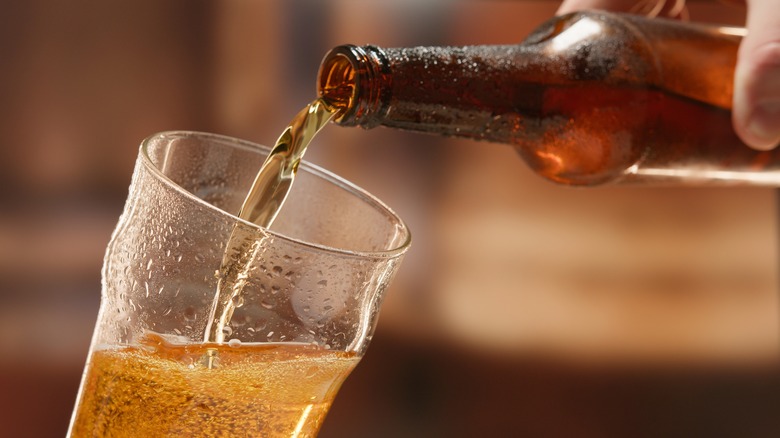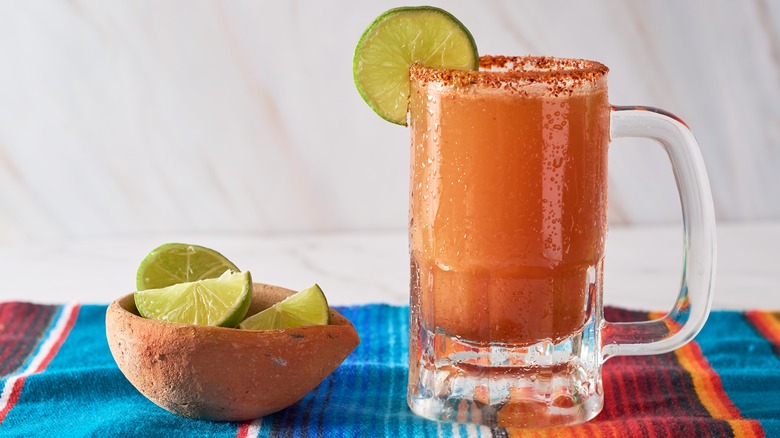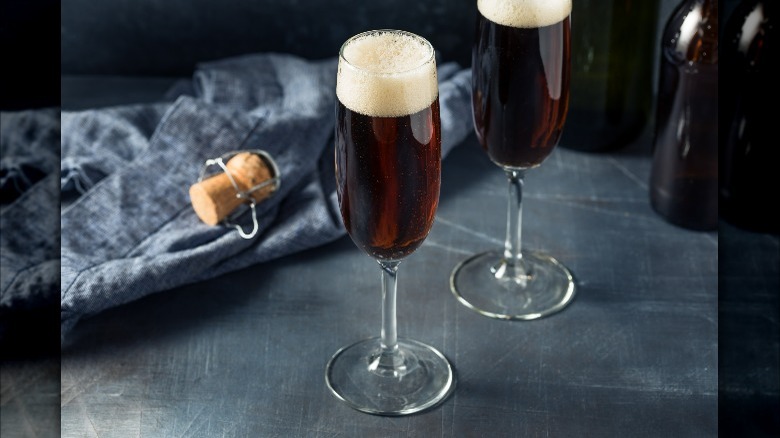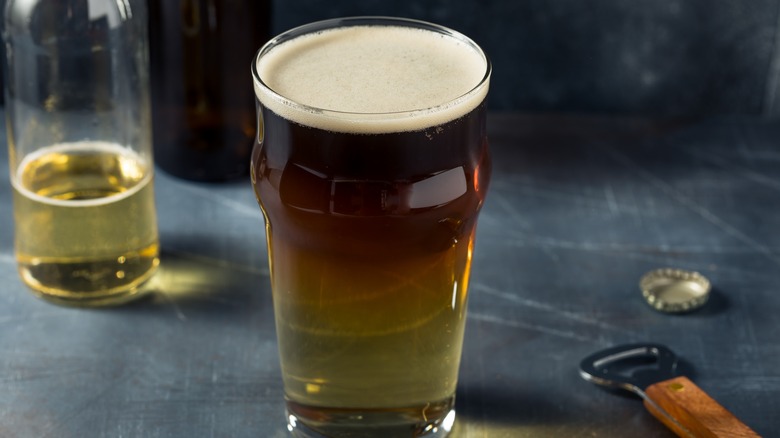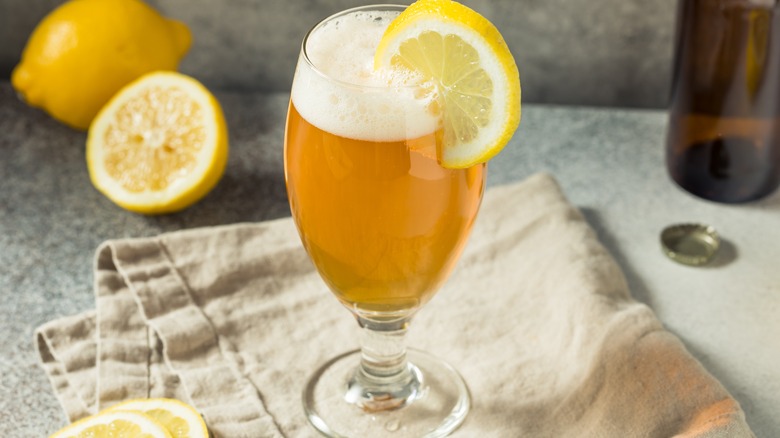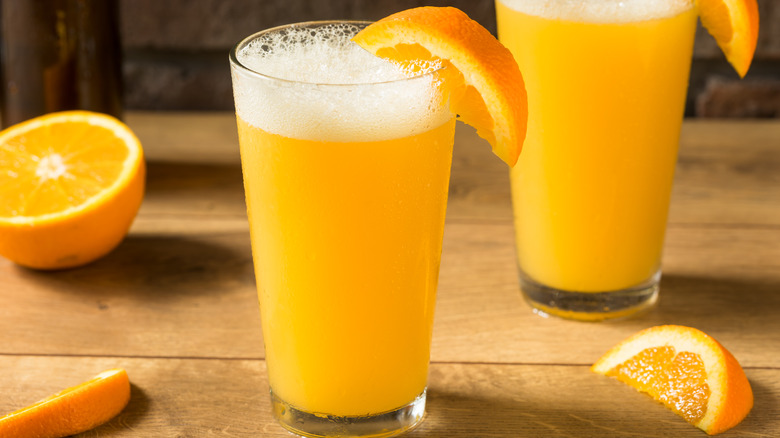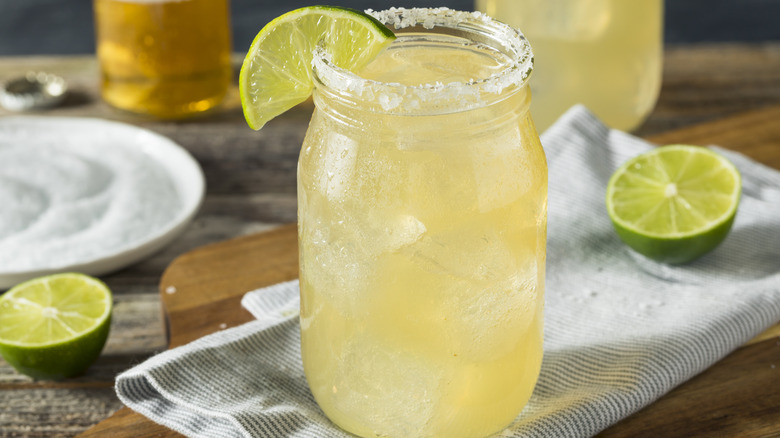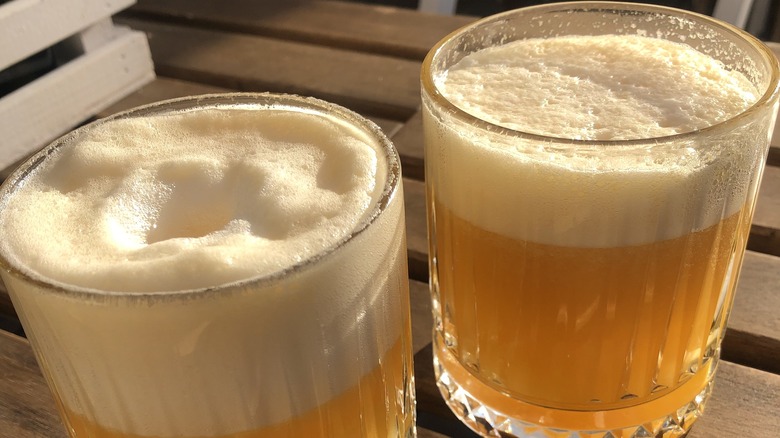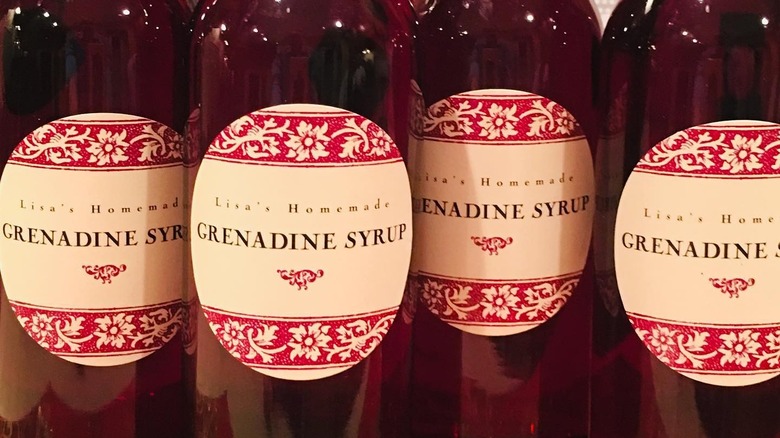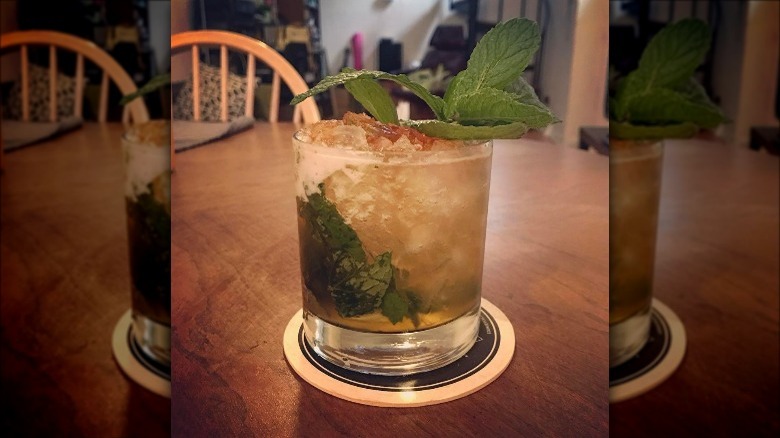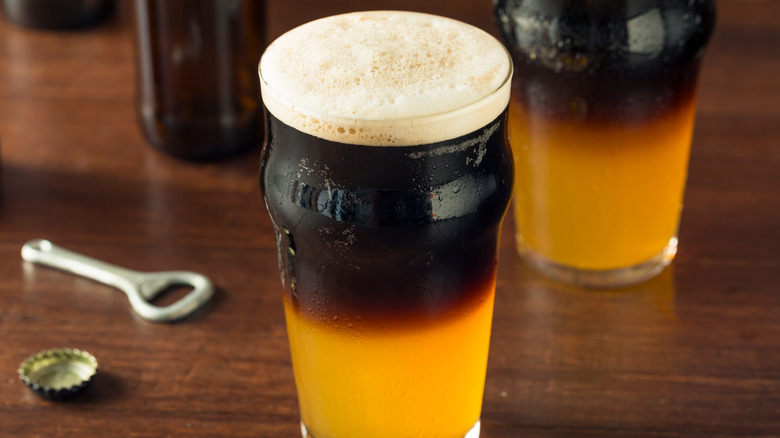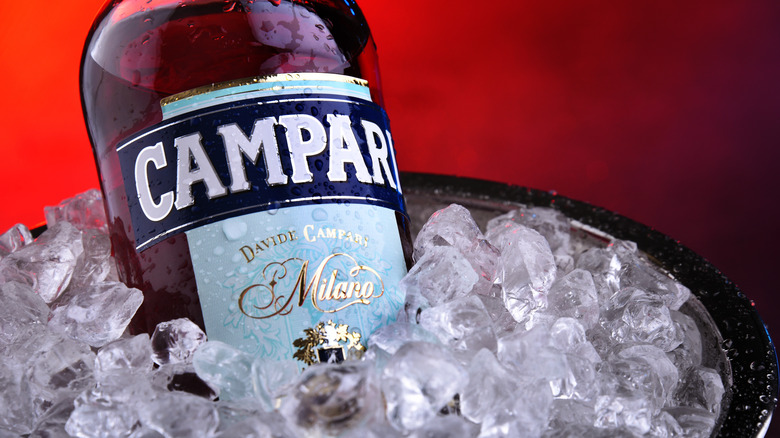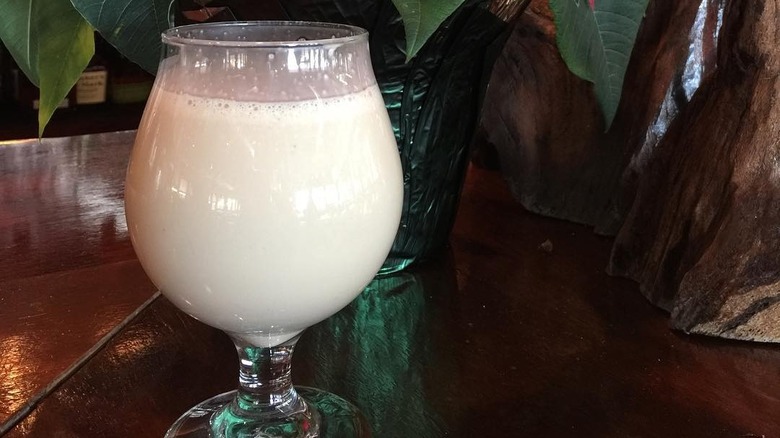The 10 Best Drinks To Mix With Beer
Ah, beer. It's the beverage of choice for game day, barbecues, happy hour, and so much more. On tap, out of the bottle, or straight from the can, there's a huge variety of styles out there from well-known macro lagers (think Budweiser and Corona) to small-batch IPAs and pilsners. But sometimes just plain old beer can be a little boring and your palate might be craving something new.
If that sounds like you, good news! There is another way to enjoy your favorite brew: the beer cocktail. Options are plentiful including unique concoctions as well as several suds-centric takes on beloved classics like the mimosa, Bloody Mary, and margarita. Mixers include both spirits and non-alcoholic beverages you might never have considered pairing with beer. Sweet, strong, refreshing, or savory, there's a beer cocktail for every palate. So let's get started: Here are the absolute best drinks to mix with beer.
Tomato juice
When beer meets Bloody Mary, how can you go wrong? The Michelada originated in Mexico, though no one is exactly sure how or when. According to the Chicago Tribune, it's possible that it was both named and created by Michel Esper Jorge at a sports bar in San Luis Potosi back in the 1970s. It may have originated in the 1940s, when people started adding hot sauce to beer. Or it could just be a simple matter of translation, since the word itself is a combination three Spanish words: "mi" for mine, "chelada" for beer, and also "helada" for cold or frost (via Tails of the Cocktail). That loosely translates to "my cold beer."
Regardless of how it began, the michelada is a Mexican staple that has been taking over the States. The basic recipe is simple. Start with a cold, light (that's light, not lite) beer of your choice, add tomato juice, hot sauce, and lime, then mix and serve over ice. From there, you can go beyond the basics. Try a chile salt or Tajin-dipped rim, a tamarind straw for a touch of sweetness, or add pureed salsa to the mix to up the heartiness. Garnishes can be anything from a simple slice of lime to celery sticks and more. And feel free to get creative with the fruits and flavor used, like this peach and tomatillo michelada cocktail recipe from Brooklyn's Leyanda.
Champagne
Fancy up your beer with a touch of luxury. Adding Champagne (or a similar white sparkling wine) to stout creates the Black Velvet, a cocktail that is over 160 years old. It was created by a London bartender in 1861 (via MasterClass). The country was reeling from the death of Prince Albert, Queen Victoria's beloved husband. The deep, dark color of the drink was meant to symbolize mourning clothes, especially those of the Queen, who wore black for the rest of her life.
Despite its funereal beginning, the Black Velvet is enjoyed throughout the world as the perfect drink. It's best made with an Irish stout like Guinness for a creamy mouthfeel as well as touches of effervescence and crisp dry notes from the sparkling wine. The idea Black-Velvet is a simple 50-50 ratio of stout to sparkling wine, poured into a Champagne flute. It's best served without any ice, so remember to chill both stout and Champagne before mixing. You also don't have to mix it. Since the stout and the champagne have different densities, a careful pour results in a layered look, with the dark beer sitting on top of the bubbly wine. Either way, it's a tasty treat.
Hard cider
A British favorite, this drink combines stout with hard cider. Reputed to get you drunker, faster, urban legends of the drink's legal status. Rumors still persist that it's illegal to serve a Snakebite in a pub. But don't you fret. BBC's Science Focus assures that this tasty cocktail is no more dangerous than a pint of beer or cider. "
This drink is served in a traditional pint glass. A traditional Snakebite is done as a layered drink, with the cider poured first followed by the beer. The cider is more dense than the beer, which is why it goes on the bottom. Done right, you end up with a drink that is light in color on the bottom and dark in color on the top. To get this mix, use the back of spoon to help pour the beer — turn the spoon over, rest the tip of the spoon near the rim of the glass, then pour the beer gently and slowly until full. Show off that perfect ombre, toast, and enjoy!
Sparkling lemonade
Looking for a way to make that cold beer even more refreshing? Try a shandy. Originally called a shandygaff, this drink has been around since the 19th century. According to Merriam-Webster, we're not exactly sure what the term shandygraff actually means or where it originated. The Victorians certainly seemed to enjoy it though. In fact, no less a luminary than Charles Dickens called the shandy a perfect "alliance between beer and pop."
While the shandy started as a mix of beer and ginger beer, using something with lemon flavor is now the standard. Many bars and pubs use lemon-lime soda, sparkling lemonade, or even flat lemonade to create their version of a perfect shandy. If you want to up your shandy game, try it with French sparkling lemonade. Not only will that give things a little panache, you can even call it that — it's French for "sparkling" and it's what they call the drink in that country.
The classic Shandy recipe is simple: lager + lemon drink of your choice in a 50-50 ratio, served in a chilled pint glass.
Orange juice
Whether you call it a beermosa or a Brass Monkey (not to be confused with the vodka-based cocktail of the same name), the combination of beer and orange juice results in a simple yet delicious beverage. It's a perfect replacement for a mimosa, especially for those who don't like the taste of champagne but still want some bubbles with their brunch.
The origin of the beermosa is unknown, but according to the Riverfront Times, it may have been created during a camping trip as a hangover cure. a bright and bubbly pilsner is an ideal stand-in for Champagne, but a blonde or wheat ale is also recommended. Next comes the orange juice — fresh-squeezed is always preferred. Serve in a chilled beer glass with an orange slice for garnish. If you want something stronger, opt for a Manmosa. The cocktail, which was created at the Mad Batter in Cape May, New Jersey, combines wheat beer, orange juice, and orange vodka.
Tequila
Mixing beer and tequila in the same glass might sound like a nightmare born in a fraternity house. Can't you just feel the hangover? But the unlikely pairing does the trick in a margarita riff. Possibly invented by UK mixologist extraordinaire Ben Reed, the lagerita is a mix of lager (preferable Mexican, like Corona or Dos Equus), tequila, orange liqueur, and lime juice (via Australian Bartender). The choice of tequila is up to you, but a quality blanco is sure to do the trick.
Prefer a standard frozen margarita? You can still add beer. Serve the frozen margarita in a large glass and up-end a bottled lager into the boozy slush. The glass you use should allow for enough space when the beer pours into the frozen margarita. Maybe keep some extra napkins on hand in case of spillover, though this style of lagerita is so tasty, that your guests might want to lick the table!
Grapefruit juice
Look at the beer selection in your local beer cave, grocery store, or liquor store and you're sure to find more than a few options that are brewed with grapefruit beer. From major names in the game to craft breweries, pre-mixed grapefruit beers aren't hard to find. Also, radlers — German shandys — often substitute grapefruit juice for lemonade.
Another way to use grapefruit juice and beer together is in a beer bellini. A traditional bellini is champagne and peach puree. But why not change things up a bit? Double the bubbles by adding beer with the champagne and switch out those peaches for some citrus. Namely, grapefruit juice. The bitter beverage mixes beautifully with the hops in IPAs and pale ales, which makes it a particularly great choice for a beerlini.
To try it yourself, mix a bottle of a grapefruit IPA with 4 ounces of grapefruit juice, gently stir in half an ounce of simple syrup (more or less, according to your taste), and top with half an ounce of champagne or prosecco. Feel free to use a regular IPA if you prefer to tone down the citrus.
Grenadine
Remember grenadine? Most of us had our first taste of the pomegranate syrup in a non-alcoholic Shirley Temple. Grenadine is a bar staple, used in cocktails such as the hurricane and the tequila sunrise. It also turns out the sweet red syrup also mixes well with beer, creating a cocktail called the Queen Mary.
Despite its very British-sounding name, the Queen Mary is considered a North American cocktail (via Gastronomic). Its sweet flavor and pink hue make it delicious and fun, and the recipe couldn't be easier. Pour a couple of teaspoons of grenadine into a pint glass. Slowly pour in a pint of beer — that gets you the frothy pink head the cocktail is known for. Throw in a few maraschino cherries and you're ready to go.
For the most refreshing Queen Mary, chill every single ingredient, almost to the point of freezing. The slightly slushy texture is perfect on a hot summer day.
Whiskey
No offense to George Thorogood, but it turns out you don't have to order one beer, one shot, and one bourbon separately. Nor do you have to drop a shot glass of whiskey into the pint glass of beer. Instead, you can mix beer and whiskey together in the same glass. That's how you end up with a new take on an old favorite — the beer julep.
Based on the classic mint Julep, a beer julep adds beer to the party. A basic mint julep recipe calls for bourbon, sugar syrup, and crushed mint leaves served over crushed ice. For a beer julep, you'll also be adding some suds to the mix (IPAs our preferable due to their hoppy bite) and a dash of Angostura bitters (an alcoholic spirit made with spices and herbs). The next time the Kentucky Derby comes around, make the beer julep your drink of choice.
Another beer
What is the easiest and arguably best drink to add to a beer? Another beer! People in England have been mixing beers since as far back as the 17th century (via Taste Atlas). What started as a way to avoid paying full beer taxes eventually turned into various drinks that people still enjoy today.
The most famous duel beer concoction is probably the Black and Tan, known as a Half and Half in Ireland. While it began as a simple mixture of both, it became known as a layered drink at some point in the 1980s. It's a very simple drink, made of equal parts dark and light beer, such as a lager and a stout, served in a pint glass. Start with the lighter beer first, then add the darker one. It's common practice to pour the darker beer over a spoon to get the ombre effect that defines the drink.
Aperitif
Remember when white wine spritzers were a thing? The basic recipe was simple: white wine, soda water, and an aperitif like Campari or Aperol. It's a summertime staple due to its light and refreshing flavor. It's also a popular palate cleanser or opener. Aperitifs like Campari and Aperol are known as excellent drinks to serve before dinner in order to open the palate for the meal to come.
They're not the only drinks to serve before dinner, however. Light white wines and light beers such as wheat beers or pale ales can serve the same purpose. That means a beer spritz can also be an excellent pre-meal drink to offer guests. To make a beer spritz, stick with lighter beers such as a pale ale or lager. For something more hop-forward, combine your favorite IPA with Campari and serve over ice and garnished with an orange rind. If the sweeter taste of Aperol is more to your taste, that's fine too. Since citrus juices play well with both Aperol and Campari, get creative with your mixes by adding a splash of orange or lemon juice and enjoy your pre-dinner treat.
Eggnog
When the holidays come, so do cartons of eggnog. It's a divisive holiday treat, but the truth is many haters may not be familiar with homemade eggnog, which is a far cry from the thick premade stuff you get at the grocery store. Real eggnog is made from egg yolks, milk, heavy cream, nutmeg, vanilla and a half cup of liquor, usually rum, brandy, or bourbon. But lately, some people are opting to switch out the liquor for something more familiar — beer.
Mixing beer into cream or milk might sound like a terrible idea, but it's a centuries-old tradition. In Medieval times up to around the 17th century, a drink called a posset was very popular. According to Smithsonian Magazine, a posset is a mixture of alcohol such as wine or beer, cream, sugar, and egg. Sometimes it was thickened with oat paste or even bread to form a thick layer on top. Possets were served in a posset pot, a drinking vessel with two handles and a spout. You'd drink the liquid from the spout, leaving the thicker upper layer to be eaten with a spoon.
Beer eggnog, or beernog, is made with dark beer, such as stout. Using the beer in place of a more traditional liquor like brandy or rum brings out different tasting notes like chocolate and caramel. So when December rolls around, break out the beernog and ensure your holidays extra happy — and hoppy.
